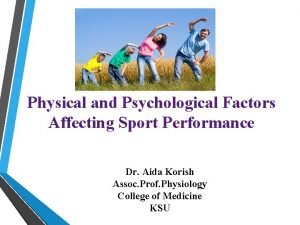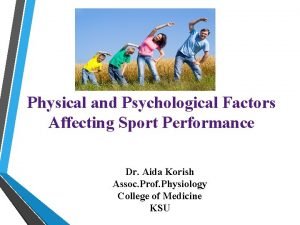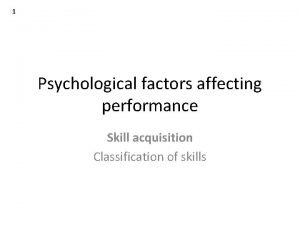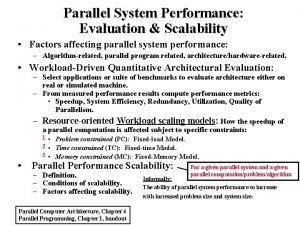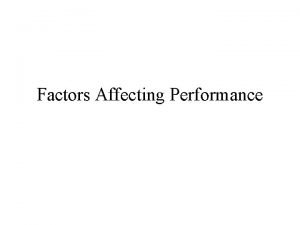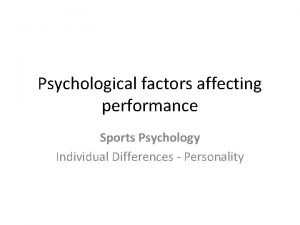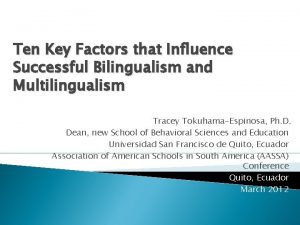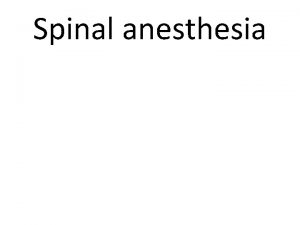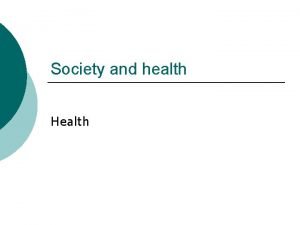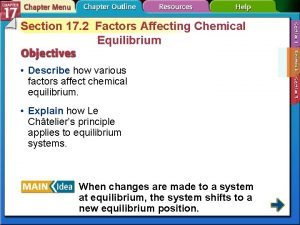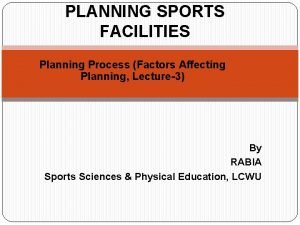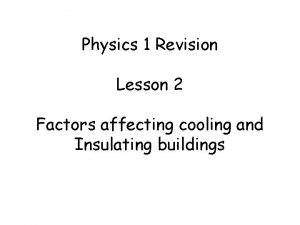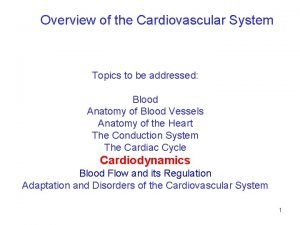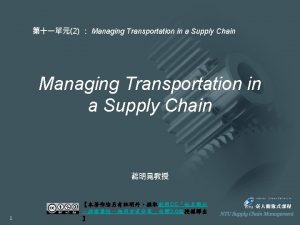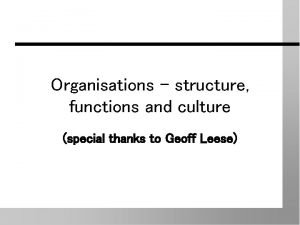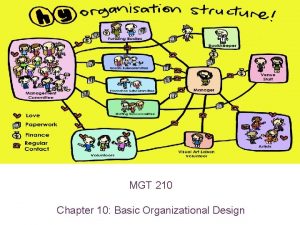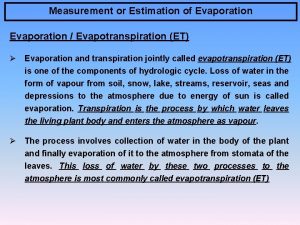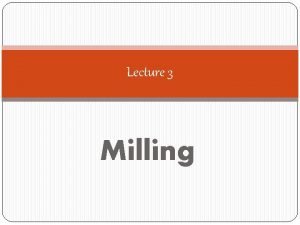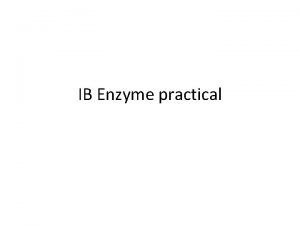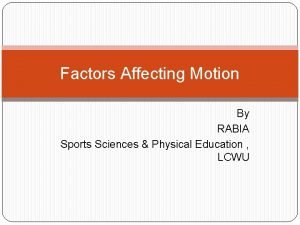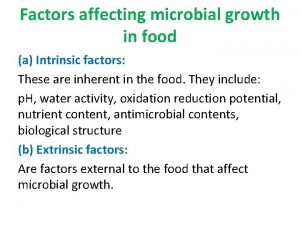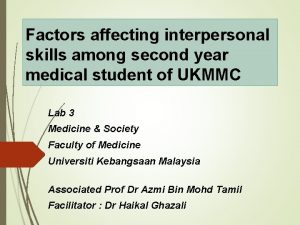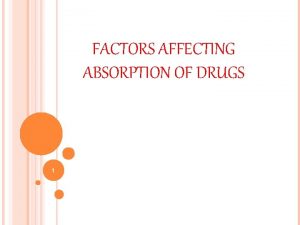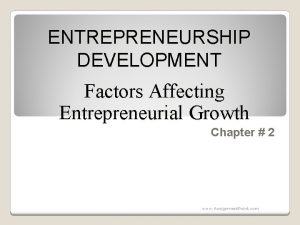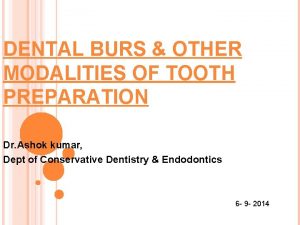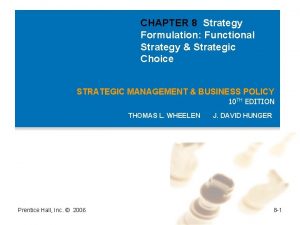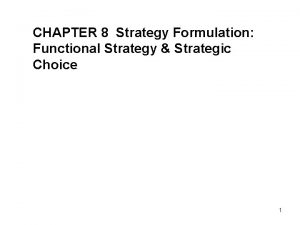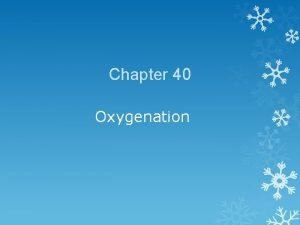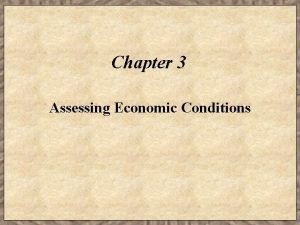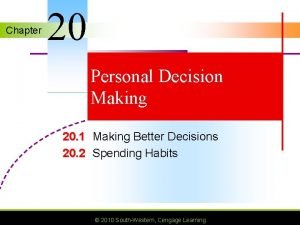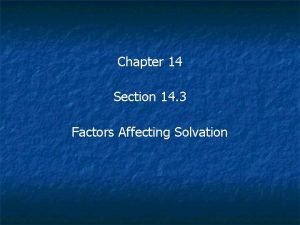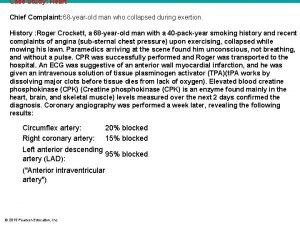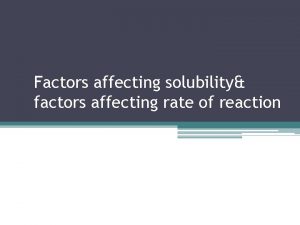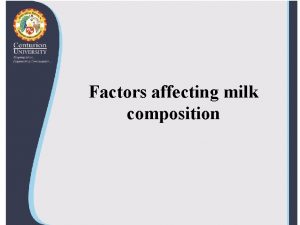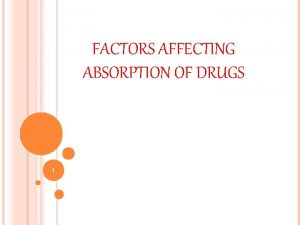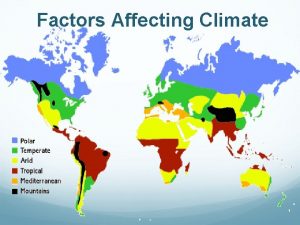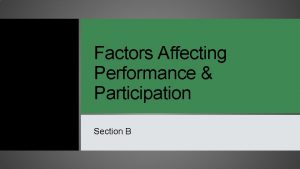EDUCATION 652 Dr Pierangelo Factors Affecting Curriculum Performance















































































- Slides: 79

EDUCATION 652 Dr. Pierangelo Factors Affecting Curriculum Performance in Children with Special Needs

Factors Affecting Curriculum Performance in Children with Special Needs o. Children are faced with many pressures everyday and as a result these pressures may play a role in their ability to fully concentrate in school.

Factors Affecting Curriculum Performance in Children with Special Needs o What you notice as a special education teacher may only be symptoms of these pressures i. e. procrastination, avoidance, resistance, lack of completion of a task, lack of attention etc

Factors Affecting Curriculum Performance in Children with Special Needs o However, the real reasons behind these behaviors should be known by you so that you can, along with the special education teacher, make accommodations or adaptations to the curriculum to help these students succeed.

Symptoms vs. Problems o. Children and adults are exposed to a variety of stressors on any given day. For children, these stressors may manifest themselves in school related symptoms which result in dysfunction.

Symptoms vs. Problems o All problems create tension. o This tension must be relieved either verbally or behaviorally. o If a child is unable to communicate his feelings, as is the case for most children, then that tension will exhibit itself in symptomatic behavior.

Symptoms vs. Problems o This symptomatic behavior is what teachers see every day in the classroom. While symptoms may not always indicate a serious problem, the frequency, intensity, and duration of the symptoms usually do.

Symptoms vs. Problems o. If a teacher understands the nature of symptomatic behavior and makes the proper referral for guidance, then a more serious problem can be averted.

Symptoms vs. Problems o However, even if correctly identified, a child’s symptomatic behavior may take a while to dissipate. o It is during this time that teachers can use certain techniques which may calm the child, provide suitable boundaries, reduce classroom frustration, and so on, while the real problem is being resolved. o These are called adaptations

ACADEMIC FACTORS o There will always be times when academic deficits will impair a child’s ability to function in the classroom. o These deficits will make it hard for the child to keep up with the other students and may require added time to complete tasks.

ACADEMIC FACTORS o Further, a lack of academic skills may also be the cause of resistance and opposition to learning. o Knowing what is behind resistance may make it easier to overcome it. o Factors that can contribute to academic dysfunction include but are not limited to:

ACADEMIC FACTORS o developmental reading disorders o developmental math disorders o developmental writing disorders o developmental spelling disorders

ACADEMIC FACTORS o poor prior teaching o lack of basic skills o inconsistency during critical periods of skill development o problems in concept formation o lack of reinforcement

ENVIRONMENTAL FACTORS o Students have lives outside of school and all to often, these lives are filled with turmoil, chaos and dysfunction. o When a child is exposed to these factors it drains them of their energy which makes it harder to concentrate and attend while in school

ENVIRONMENTAL FACTORS o After all, children who may experience violence in the home are more worried about going home after school then concentrating on math problems.

ENVIRONMENTAL FACTORS o Environmental factors are defined as those factors which the child may be exposed to at home or in the community which may have a profound impact on the child’s ability to function in school. o These factors may include home issues such as:

ENVIRONMENTAL FACTORS oparental abuse oparenting fighting oseparation odivorce ofamily illness

ENVIRONMENTAL FACTORS oeconomic hardships oloss of parent’s job omoving into a new neighborhood oserious sibling rivalry ofamily mental illness

ENVIRONMENTAL FACTORS orelatives residing in the home oalcoholism odrug abuse

ENVIRONMENTAL FACTORS Environmental factors may also originate from community issues such as: o problems with neighbors o poor reputation in the neighborhood o problems with the law

INTELLECTUAL FACTORS o. While a child’s ability may vary, it is imperative that as a teacher you have a good idea of each child’s true ability level so that you do not frustrate him/her and adapt the curriculum to his/her needs

INTELLECTUAL FACTORS When these factors are present, a child’s stress may be manifested in a variety of symptoms. The factors which fall under this category include: o Undetected limited intellectual ability o Undetected gifted intellectual capacity

LANGUAGE FACTORS o Language provides the foundation upon which communication, problem solving, integrating, analyzing, and synthesizing knowledge takes place. o Therefore, deficits in language can have a profound impact on the ability of an individual to learn and function competently and confidently as he interacts in the world.

LANGUAGE FACTORS Difficulties may arise in a child’s language development resulting in classroom symptoms. These language issues may arise from difficulties in: o nonverbal language o oral language (i. e. , listening and speaking) o written language (i. e. , reading and writing),

LANGUAGE FACTORS o pragmatic language (e. g. , using language for a specific purpose such as asking for help) o word retrieval o articulation o receptive aphasia o expressive aphasia o bilingualism

MEDICAL FACTORS o. While teachers are not asked to be doctors, certain medical conditions may manifest certain symptoms in the classroom. o For the most part, one would assume that any serious medical condition may have already been identified by the child’s pediatrician or parent.

MEDICAL FACTORS o However, this may not always be the case, especially in the cases of very young children. o However, certain more common medical problems that may impair a child’s ability to function adequately in the classroom may include but are not limited to:

MEDICAL PROBLEMS o attention deficit disorder o vision problems o hearing problems o neurological problems o muscular problems o coordination problems

PERCEPTUAL FACTORS o The learning process is like an assembly line through which information received travels. o Information is received in some manner, and is filtered through a series of psychological processes.

PERCEPTUAL FACTORS o As information progresses along this "assembly line", it is given meaning and organized in some fashion, and then expressed through a variety of responses.

PERCEPTUAL FACTORS o When we evaluate a child's perceptual abilities, we are looking to see if there is a deficit in some area of the learning process that may be slowing down the processing of information, thereby interfering in the child's ability to receive, organize, memorize or express information. o Severe deficits in the learning process can have adverse affects upon a child's academic performance.

PSYCHOLOGICAL FACTORS o Tension is a factor that is present in many children and the greater the tension, the greater the impact on a child’s ability to learn. o As tension rises it affects a child’s ability to concentrate, focus, remember and store information, participate, keep things in perspective and remain patient

PSYCHOLOGICAL FACTORS Psychological factors which may be contributing to a child’s dysfunction in school may include but are not limited to: o clinical depression o mental illness o anxiety

PSYCHOLOGICAL FACTORS o eating disorders o personality disorders o schizophrenia o phobias

PSYCHOLOGICAL FACTORS o obsessive compulsive disorders o psychosexual dysfunction o substance abuse o sleep disorders o brief situational disturbances or adjustment reactions o conduct disorders o separation anxiety o oppositional defiant disorders

SOCIAL FACTORS While social status is a crucial factor at many ages, it becomes more of a factor as one approaches the period of adolescence. o.

SOCIAL FACTORS o Social pressures and peer influence sometimes create an imbalance in a child’s functioning. o This imbalance may often result in lower available energy for school related issues because of the intense need for energy to cope with his social world or social conflicts.

SOCIAL FACTORS Social factors which may lower available energy and result in academic dysfunction include: o peer rejection o preoccupation with boyfriend or girlfriend o low social status o social victimization o scapegoat

SOCIAL FACTORS o difficulty with social intimidation o victim of bully behavior o social control issues-the need to be in control o peer competition o social isolation o social overindulgence

FACTORS AFFECTING CURRICULUM o Finally, it would be helpful at the beginning of the semester to try to determine which of these areas affect each of your students. o Once you have determined this you may need assistance from other staff members to help the student.

Adapting Curriculum -Part II-Learning Disabilities For Students with Special Needs Education 652 Dr. Pierangelo

Adapting Curriculum o One of the most important things to keep in mind when working with students with special needs is that they can learn. o In many cases, it is not the lack of understanding or knowledge that causes problems but rather the manner of presentation, response requirements, and level of presentation.

Adapting Curriculum o The need to learn how to adapt material is crucial when working with this population. o These adaptations offer them a better chance of success and task completion.

Wh 0 gets Curriculum Adaptations? o The chances are that if you are working in a regular school district you will come into contact with high incidence disabilities. These may include: o Learning Disabilities o Mental Retardation o Emotional Disabilities o Other Health Impaired: Attention Deficit/Hyperactive Disorder

Adapting Curriculum for Children with Learning Disabilities o The teacher should be aware that not all techniques will work with all students, but try as many of them as possible. These techniques should create a better learning environment for children with learning disabilities.

Adapting Curriculum for Children with Learning Disabilities A-Make adjustments in the type, difficulty, amount and sequence of materials o 1. Give shorter but more frequent assignments.

Adapting Curriculum for Children with Learning Disabilities o 2. Shorten the length of the assignments to insure a sense of success. o 3. Copy chapters of textbooks so that the child can use a highlighter pen to underline important facts.

Adapting Curriculum for Children with Learning Disabilities o 4. Make sure that the child's desk is free from all unnecessary materials. o 5. Correct the student's work as soon as possible to allow for immediate gratification and feedback.

Adapting Curriculum for Children with Learning Disabilities o 6. Allow the student several alternatives in both obtaining and reporting information-tapes, interviews and so on.

Adapting Curriculum for Children with Learning Disabilities o 7. Hold frequent, even if short conferences with the child to allow for questions, sources of confusion, sense of connection and avoidance of isolation which often occurs if the work is too difficult.

Adapting Curriculum for Children with Learning Disabilities Adjust space, work time and grouping 1. Permit the child to work in a quiet corner, a study carrel when requested or necessary. This should not be all the time since isolation may have negative consequences. This technique depends on the specific learning style of the child who may be less distracted by working under these conditions.

Adapting Curriculum for Children with Learning Disabilities o 2. At first the teacher may want to place the child closer to her/him for more immediate feedback. o 3. Try to separate him/her from students who may be distracting.

Adapting Curriculum for Children with Learning Disabilities o 4. Alternate quiet and active time to maintain levels of interest and motivation. o 5. Make up a work contract with specific times and assignments so that the child has a structured idea of his/her responsibilities

Adapting Curriculum for Children with Learning Disabilities

Adapting Curriculum for Children with Learning Disabilities o 6. Keep work periods short and gradually lengthen them as the student begins to cope. o 7. Try to match the student with a peer helper to help with understanding assignments, reading important directions, drilling him/her orally , summarizing important textbook passages and working on long range assignments.

Adapting Curriculum for Children with Learning Disabilities Consider adjusting presentation and evaluation modes Some students learn better by seeing (visual learners), some by listening (auditory learners), some by feeling (tactile learners) and some by a combination of approaches.

Adapting Curriculum for Children with Learning Disabilities o Adjustments should be made by the teacher to determine the best functional system of learning for the children with learning disabilities. This will vary from child to child and is usually included in the child's evaluation.

Adapting Curriculum for Children with Learning Disabilities o If the child is primarily an auditory learner, offer adjustments in the mode of presentation by use of the following techniques: o 1. Give verbal as well as written directions to assignments.

Adapting Curriculum for Children with Learning Disabilities o 2. Place assignment directions on tape so that students can replay them when they need. o 3. Give students oral rather than written tests. o 4. Have students drill on important information using tape recorder, reciting information into the recorder and playing it back.

Adapting Curriculum for Children with Learning Disabilities o 5. Have students drill aloud to themselves or to other students. o 6 - Have children close their eyes to try and hear words or information.

Adapting Curriculum for Children with Learning Disabilities If the child is primarily a visual learner, offer adjustment in the mode of presentation by: o 1. Have students use flash cards printed in bold bright colors. o 2. Let students close their eyes and try to visualize words or information in their heads, see things in their minds.

Adapting Curriculum for Children with Learning Disabilities o 3. Provide visual clues on chalkboard for all verbal directions. o 4. Encourage students to write down notes and memos to themselves concerning important words, concepts, and ideas.

Adapting Curriculum for Children with Learning Disabilities For students with organizational problems try adapting the materials in the following manner: o Use large print activity sheets. o Use overlays on text pages to reduce the quantity of print that is visible. o Highlight key points on the activity sheet. o Line indicators

Adapting Curriculum for Children with Learning Disabilities o Sections on paper (draw lines, fold) o Different types of paper (e. g. , graph, paper with mid-lines, raised line paper) o Provide more white space to put answers o Highlight or color code (directions, key words, topic sentences)

Adapting Curriculum for Children with Learning Disabilities o Put less information on a page o Use high contrast colors Adapt Assistance o Use peers or volunteers to assist students with special needs. o Use students with special needs to assist younger students in learning science.

Adapting Curriculum for Children with Learning Disabilities Preparing for Tests and Quizzes o Teach students strategies to prepare for a test or quiz o Teach students what to look for in test questions; how to read a test o Use a variety of formats to thoroughly review for several days before tests or quizzes including quiz bowls, small group review, question and answer periods and study buddies.

Adapting Curriculum for Children with Learning Disabilities o Provide students with examples of test content and format. o Provide study guides in advance of the test. o Provide review time during or outside of the class, emphasizing key points to study.

Adapting Curriculum for Children with Learning Disabilities Writing Tests or Quizzes o Write clear, concise directions. o Vary the test format (e. g. , written, oral, short answer, essay, multiple choice, matching, yes/no, demonstration testing, open book/notes, take home, cooperative group testing). o Underline or highlight important words in the test directions or on test items.

Adapting Curriculum for Children with Learning Disabilities o Give more objective than subjective items. o Increase allowable time for test completion.

Adapting Curriculum for Children with Learning Disabilities o Review orally to ensure comprehension of essay questions. o Give shorter tests, covering less information, more frequently. o Avoid penalizing for grammar, handwriting, or spelling.

Adapting Curriculum for Children with Learning Disabilities o Reduce the test items by starring those that are the most important concepts. o Give the same test to all students, but score some students on the priority items only, giving extra credit for any additional questions answered correctly.

Adapting Curriculum for Children with Learning Disabilities Administering and Scoring Tests and Quizzes o Provide students with the opportunity to have tests read orally. o Read test instructions aloud to any student who would prefer them read aloud.

Adapting Curriculum for Children with Learning Disabilities o Allow students to take the test in the classroom during the scheduled time, then give opportunities to have it read to them orally and average the two scores. o Tape record tests, using assistants, tutors, parent volunteers and others. o Allow students to tape record answers.

Adapting Curriculum for Children with Learning Disabilities o Allow students to use charts, calculators, or manipulatives that they have used on assignments for the exam. o Create a modified grading scale or consider a pass/fail, satisfactory/ unsatisfactory grade on the test. o Grade student effort and individual ability in addition to test scores.

Adapting Curriculum for Children with Learning Disabilities o Allow students to retake the test and give credit for improvement. o Provide feedback to students via teacher/student conferences. o Encourage students to chart their progress.

Adapting Curriculum for Children with Learning Disabilities o Take time to review corrected tests and allow students to make corrections on their test or a clean copy of the test. o Provide partial credit for various correct steps in a problem-solving process. o Correct tests immediately and reteach in skill groups.

Adapting Curriculum for Children with Learning Disabilities o Give students opportunity to critique their own work based on your criteria before they hand it in. o Allow students to grade their own tests immediately upon completion in a designated area; the teacher does the final scoring. o Allow students to take the test in small groups; students may use a group answer or their own.

Adapting Curriculum for Children with Learning Disabilities o_ Each student has her own test so that if there is disagreement each can write her own answer o_ Both partners must be present on the day of the test or the test is taken alone

Allow test partners: o _ Offer it as a student option o _ Each student has his own set of notes and his own copy of the test o _ Student partners are allowed to read and discuss questions, then each student writes her own answer
 Psychological factors affecting sports performance
Psychological factors affecting sports performance Physiological factors affecting performance
Physiological factors affecting performance Internally paced skill examples
Internally paced skill examples Factors affecting performance of parallel algorithm
Factors affecting performance of parallel algorithm Factors affecting performance
Factors affecting performance Id psychology example
Id psychology example Factors that affect movement in physical education
Factors that affect movement in physical education Naca 2413
Naca 2413 Commonwealth coordinated care plus
Commonwealth coordinated care plus Api 652
Api 652 What factors shape the climate in canada
What factors shape the climate in canada Factors affecting microbial growth in food
Factors affecting microbial growth in food Factor affecting volcanic eruption
Factor affecting volcanic eruption Factors affecting volcanic eruption
Factors affecting volcanic eruption When does the simple carburetor supplies rich mixture
When does the simple carburetor supplies rich mixture Application of tga
Application of tga V-list link
V-list link Factors of bilingualism
Factors of bilingualism Human movement impact factor
Human movement impact factor Stroke volume
Stroke volume Baricity of local anesthetics
Baricity of local anesthetics Regolith in soil profile
Regolith in soil profile Factors affecting health
Factors affecting health Section 17.2 factors affecting chemical equilibrium
Section 17.2 factors affecting chemical equilibrium Factors affecting sample size
Factors affecting sample size What is merchandising
What is merchandising Factors that affect the planning process
Factors that affect the planning process Factors affecting evaporation
Factors affecting evaporation First pass effect
First pass effect Co = hr x sv
Co = hr x sv Average revenue
Average revenue Factors affecting span of control
Factors affecting span of control Steep incisal guidance
Steep incisal guidance Factors affecting bacteria growth
Factors affecting bacteria growth Contingency factors affecting structural choice
Contingency factors affecting structural choice Factors affecting evapotranspiration
Factors affecting evapotranspiration Factors affecting milling process
Factors affecting milling process What are the factors affecting the climate
What are the factors affecting the climate Factors affecting enzyme activity temperature
Factors affecting enzyme activity temperature Explain the factors affecting gfr
Explain the factors affecting gfr How does gender affect optimum weight
How does gender affect optimum weight Factors affecting fermentation
Factors affecting fermentation Factors affecting fermentation
Factors affecting fermentation Factors affecting powder flow
Factors affecting powder flow Factors affecting interior design
Factors affecting interior design Factors affecting interior design
Factors affecting interior design Factors that influence the communication process
Factors that influence the communication process Local factor affecting wound healing
Local factor affecting wound healing Rate of reaction graph
Rate of reaction graph Factors affecting air resistance
Factors affecting air resistance Factors affecting population explosion
Factors affecting population explosion Factors affecting organizational structure
Factors affecting organizational structure Factors affecting option premium
Factors affecting option premium Factors that affect inertia
Factors that affect inertia Water activity of microorganisms
Water activity of microorganisms Factors affecting interpersonal skills
Factors affecting interpersonal skills Factors affecting human resource planning
Factors affecting human resource planning Factors affecting equilibrium
Factors affecting equilibrium Density of milk
Density of milk Ph partition theory
Ph partition theory Factors that influence plant layout
Factors that influence plant layout Factors affecting esp course design
Factors affecting esp course design Cultural factors affecting entrepreneurial growth
Cultural factors affecting entrepreneurial growth Different social factors
Different social factors Parts of a dental bur
Parts of a dental bur Fringed micelle model
Fringed micelle model Factors affecting consensus in law
Factors affecting consensus in law Managerial functions
Managerial functions Factors affecting strategic choice
Factors affecting strategic choice Subjective factors in strategic choice
Subjective factors in strategic choice Factors affecting oxygenation in nursing foundation
Factors affecting oxygenation in nursing foundation Factors affecting fermentation
Factors affecting fermentation Factors affecting inflation
Factors affecting inflation First step of decision making
First step of decision making 3 factors that affect solvation
3 factors that affect solvation Factors affecting cardiac output
Factors affecting cardiac output Heart physiology
Heart physiology Factors to be considered for selection of bridge site
Factors to be considered for selection of bridge site Factors affecting absorption of drug
Factors affecting absorption of drug Factors affecting sleep
Factors affecting sleep
